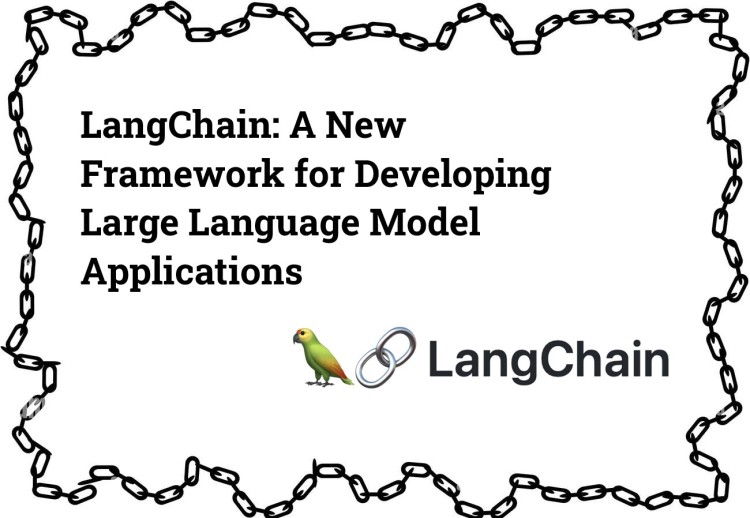LangChain: A New Framework for Developing Large Language Model Applications

Large language models (LLMs) have the potential to bring about a significant transformation in how we create AI applications. They possess the capability to generate text, translate languages, craft diverse forms of creative content, and offer insightful responses to your queries. Nevertheless, working with LLMs can be intricate and challenging, particularly for developers who aren't well-versed in natural language processing.
Enter LangChain, a novel open-source framework that simplifies the process of crafting applications powered by LLMs. It offers a user-friendly standard interface for chains, boasts numerous integrations with various tools, and provides ready-made chains for common applications. This means that AI developers can concentrate on building their applications without being burdened by the intricacies of LLMs that operate underneath the surface. With LangChain, the power of LLMs becomes more accessible to a broader spectrum of developers, making AI development more approachable and practical.
LangChain can be used to build a wide variety of applications, such as:
- Chatbots
- Document question answering
- Code generation
- Data analysis
- Code review
- Creative writing
- And more
Benefits of using LangChain
- Simplicity: LangChain offers a straightforward and user-friendly platform for creating applications powered by Large Language Models (LLMs). This means that developers, regardless of their expertise in natural language processing, can easily begin using it.
- Flexibility: LangChain is an adaptable framework capable of constructing a broad range of applications using LLMs. It doesn't confine developers to particular use cases or application categories.
- Capability: LangChain leverages the potential of LLMs to construct smart and robust applications. With LangChain, applications can tackle intricate tasks, like creating code, addressing queries on complex subjects, and producing imaginative content.
LangChain consists of six key modules that work together to create a versatile framework for Language Model (LLM) powered applications:
- Model I/O: This module serves as the bridge between users and language models, providing a user-friendly interface for interacting with language models like GPT-3, Megatron-Turing NLG, and LaMDA.
- Retrieval: The Retrieval module allows LangChain to access external sources such as databases, search engines, and APIs, enabling it to draw upon real-world data to craft informed responses.
- Chains: With the Chains module, LangChain can sequence a series of actions involving language models and other modules, enabling it to create complex applications that execute multiple tasks in a single streamlined process.
- Agents: The Agents module empowers chains to make intelligent decisions based on high-level directives. This adaptability enables the development of applications that can respond to changes in the environment or user input.
- Memory: LangChain's Memory module provides a mechanism for retaining application state across chain runs. This enables LangChain to build applications that learn and improve over time through user interactions.
- Callbacks: The Callbacks module allows the logging and streaming of intermediate steps in any chain. This functionality is vital for debugging and monitoring LangChain applications to ensure they run smoothly.
These modules can be combined in various ways to create a broad spectrum of LLM-powered applications, including chatbots, document question answering systems, code generators, and data analysis tools.
To illustrate how these modules work together, let's consider building a chatbot using LangChain:
- The Model I/O module would facilitate communication with the GPT-3 language model, handling user interactions.
- The Retrieval module would enable the chatbot to fetch relevant data from a database of pre-defined chatbot responses.
- The Chains module would orchestrate the sequence of actions, combining calls to the GPT-3 language model and the retrieval module to generate engaging and informative responses to user queries.
- The Agents module would let the chatbot intelligently decide which tools to use based on the user's input. For example, if a user poses a specific question, the chain could utilize the retrieval module to fetch a relevant response from the database. For more general questions, the chain might opt to use the GPT-3 language model for generating a response.
- The Memory module would allow the chatbot to retain knowledge and context from previous interactions, enhancing its ability to learn and adapt over time.
- The Callbacks module would serve as a tool for tracking the chatbot's steps, enabling monitoring and debugging to ensure the chatbot operates smoothly.
LangChain, while still in development, holds great promise in revolutionizing the way we create AI applications, offering a powerful and adaptable framework for LLM-powered solutions.
Conclusion
In conclusion, LangChain emerges as a promising solution for streamlining the development of applications powered by Large Language Models (LLMs). Its user-friendly approach simplifies the complexities of working with LLMs, making AI development more accessible to a wider range of developers. LangChain's six key modules offer a versatile framework for crafting various LLM-powered applications, from chatbots to code generators. Its benefits lie in its simplicity, flexibility, and capability, promising to revolutionize the landscape of AI application development. As it continues to evolve, LangChain holds the potential to unlock the true power of LLMs, offering a practical and adaptable framework for building intelligent and sophisticated applications.
Add new comment
- 203 views
